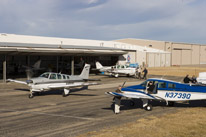
Illustration: John Holm
States recognize aviation’s economic impact
Three more states—and several communities within those states—have issued proclamations recognizing the value of aviation, and the jobs and opportunities it creates. In Florida, Louisiana, and Oklahoma, proclamations help recognize that aviation increases opportunities for communities to thrive.
Georgia became the first state to recognize aviation’s many contributions, in 2009, and all 50 states had taken the same step by 2014. AOPA Northwest Mountain Regional Manager David Ulane noted that the increasing number of proclamations extends awareness to local officials who play a direct role in supporting airports, aviation businesses, and other critical infrastructure. Those proclamations also raise awareness among members of the nonflying public that they benefit from their local airports and associated businesses.
Ulane, celebrating Utah’s recent proclamation, urged members to thank lawmakers for recognizing the value of aviation. AOPA Central Southwest Regional Manager Yasmina Platt had the same message for members in Oklahoma following Gov. Mary Fallin’s signature in March of a proclamation that recognizes the $1.2 billion in economic activity made possible by aviation.
Platt also thanked Louisiana Gov. Bobby Jindal for recognizing the 58,900 jobs and $6.7 billion in economic activity (including $3.3 billion spent by air travelers) created in his state. Local communities in Louisiana also joined the growing list of cities and towns expressing their appreciation, with proclamations issued by mayors in Baton Rouge, Hammond, New Iberia, and Ruston.
Florida Gov. Rick Scott reiterated his state’s appreciation of the $144 billion in economic activity associated with aviation, noting that 8.5 percent of the state’s total economic output comes from businesses that depend on aviation. The state, Scott proclaimed, “has a significant interest in the continued vitality of aviation, aircraft and aerospace manufacturing, commercial service and community airports, and aviation education.”
SURVEY: 28% of AOPA members live in California, Florida, and Texas.
Lockheed and CSC to provide DUAT service
Lockheed Martin and CSC will provide Direct User Access Terminal (DUAT) II services to pilots under new contracts announced by the FAA. Each company has been awarded a one-year fixed-price contract to supply DUAT II services, with up to four one-year renewals. DUAT allows pilots to use the Internet to access weather and flight planning information, as well as to file and cancel flight plans.
The DUAT program was first implemented in 1989, and since that time services have been provided by CSC and DTC. Lockheed Martin began offering Internet-based service in 2012. The new contracts mark the first time DTC will not have a role to play in providing DUAT services. DTC was given a 60-day transition period.
The FAA has said that it intends to modernize flight services in the coming years, but a bid process for that effort has not yet been established. Lockheed Martin’s contract to supply flight services other than DUAT is scheduled to expire in September 2015, although the FAA has said it intends to extend that contract while it develops criteria for a modernized system.
AOPA has asked the FAA to gather user input to ensure that any changes to future flight services, such as increased automation, meet user needs. AOPA also wants to be sure that robust safety-of-flight information continues to be available at no charge to users.
Action in the states
Alaska Region
AOPA has submitted formal comments on a proposal to expand military airspace in central Alaska. AOPA expressed concern that expanding the Joint Pacific Alaska Range Complex would negatively affect general aviation safety and communications, particularly in the area between Anchorage and Fairbanks. AOPA is seeking expanded communications, minimal use of the airspace during the busy hunting season, and the elimination of a VFR corridor that would unnecessarily concentrate traffic at low altitudes.
AOPA has submitted formal comments on a proposal to expand military airspace in central Alaska.
Northwest Mountain Region
AOPA continues to fight plans to build a power plant adjacent to Oregon’s Hillsboro Airport. Thermal plume models indicate the plant would create hazardous turbulence near the airport. Construction continues on a new GA airport in Thermopolis, Wyoming. The $20 million field, which is scheduled to open later this year, will replace the community’s existing airport, which does not meet FAA standards.
Western Pacific Region
AOPA Ambassador Kay Sundaram has been busy in California, delivering “Rusty Pilots” and “iPad in the Cockpit 101” seminars to several hundred pilots at airports around the state. At a recent Rusty Pilots seminar at South County Airport, one-third of the participants immediately signed up for a flight lesson, putting them on the path back to active flying status.
Central Southwest Region
Texas Gov. Greg Abbott has signed a new law that will help protect pilots flying at low altitudes. The law requires that meteorological evaluation towers (METs) be marked and registered with the state Department of Transportation’s aviation division. The law, which takes effect September 1, also contains enforcement provisions. In Missouri, Gov. Jay Nixon was scheduled to sign a law providing a fly- away exemption for aircraft sold to non-Missouri residents and removed from the state within 10 days.
Great Lakes Region
AOPA met with officials in Ohio to seek support for less restrictive seaplane access. Currently seaplane pilots must petition the Ohio Department of Transportation to approve and inspect a landing area—and obtain Department of Natural Resources approval, and pay a fee for each lake where they want to operate. AOPA also traveled to Baudette, Minnesota, to encourage Lake in the Woods County Board members to support the creation of a new GA airport in the remote Northwest Angle.
Southern Region
Close to 2,000 remote-control aircraft pilots and 10,000 spectators descended on Triple Tree Aerodrome in South Carolina recently for Joe Nall Week 2015. The annual event is the world’s largest remote-control fly-in (see page 26). Students at Asheville-Buncombe Technical College in North Carolina will have the opportunity to earn a two-year associate’s degree in applied science that will leave graduates eligible for a restricted airline transport pilot certificate. The program kicks off August 17.
Eastern Region
AOPA is working with airport users and the manager of Bar Harbor-Hancock County Airport in Maine to resolve scheduling conflicts related to a pavement improvement and crack sealing project, which was planned during the height of tourist season. Airport Support Network volunteer Fritz Kass delivered a presentation to the Stewart Airport Commission in New York showing how a new law exempting GA aircraft from the state’s sales-and-use tax could create opportunities at the airport.
Products and Services
Pilot protection services
Listen up
Pay attention to pilot reports
By Kathy Yodice, AOPA Pilot Protection Services
When planning and executing a flight, we take in a lot of information that can help ensure the safety of that flight. Understanding what weather we may encounter during our flight is important to avoiding dangerous meteorological conditions. Forecasts and actual conditions from weather reporting facilities play a big role in our preflight weather briefings. Pilots are another source of pertinent weather information. Reports from other pilots who experience the actual conditions can help the rest of us decide whether to go—or not.
According to the Aeronautical Information Manual, a pirep or pilot weather report is a report of meteorological phenomena encountered by aircraft in flight. Pilots are urged to provide reports to ATC, especially when such reports are solicited by ATC, so that those reports can be used to expedite the safe flow of air traffic—and so that real-time information can be shared with other pilots flying in the vicinity of the report.
It’s important to consider the pireps that you receive during your preflight planning, and to listen to those that you hear while you’re en route. In at least one case, the FAA used the fact that pireps could be heard over the radio in the same sector as evidence that the airman should have known of the adverse weather conditions affecting his flight, and thus should have avoided flight into conditions that were contrary to the aircraft’s operating limitations. In particular in that case, the FAA maintained that as the pilot and his flight instructor were practicing instrument approaches in overcast and near-freezing conditions, they were able to hear other pilots reporting rime ice. During the first missed approach, the pilot noticed ice on the wings, and they came around to land but lost control of the aircraft, running off the runway and substantially damaging the aircraft. The FAA argued that they ignored the reports of ice and chose to continue their flight into known icing conditions. In affirming the FAA’s charges of FAR violations, the NTSB found that the weather forecasts presented a clear risk of icing and that the pilot and his flight instructor heard or should have heard the pireps, which they should have discerned came from the vicinity of the airport they were approaching. The NTSB held that it was clear error for them to have continued the flight when further evidence of actual icing or reported icing presented itself.
There was more to the case, as there often is. Still, for our purposes in reinforcing that pireps are to be included in our decision making, this case reminds us to “listen up” on the radio for any information that may be relevant to our flight.
Kathy Yodice is an aviation attorney for AOPA’s Pilot Protection Services and Legal Services Plan. She’s assisted AOPA members for more than 13 years and is a former FAA attorney. She owns a Cherokee 180 and has been a pilot since 1994.
Insurance services
AOPA INSURANCE ANNOUNCES NEW HANGAR COVERAGE
AOPA Insurance Services has created an exclusive hangar insurance program that offers another way to help lower the cost of airplane ownership, while protecting valuable member assets. The new AOPA hangar insurance program protects individuals who own or lease hangars in cases of hangar damage, personal injury, fire, wind damage, or theft for as little as $42 a month. The policy covers hangars and associated property with deductibles as low as $1,000.
“It’s hard to put a price on knowing there is a safety net between you and a natural or man-made catastrophe,” said Brenda J. Jennings, AOPA Insurance Services senior vice president. “AOPA is proud to announce our new hangar insurance program that provides peace of mind through comprehensive coverage and affordable rates.”
The program provides premises liability coverage of $1 million to $5 million for each occurrence, and medical expense coverage of $1,000 per person. Optional coverages include business property, loss of revenue, and more.
AOPA hangar insurance can be tailor-made for hangars that are owned or leased, and can even cover hangars located on the Atlantic and Gulf coasts.
To find more information on AOPA hangar insurance visit the website or call 800/622-AOPA (2672).
AOPA Foundation
You’re passionate about flying and safety. Why not be passionate about giving, too? Your donation to the AOPA Foundation helps fund the Air Safety Institute’s free aviation education products such as those below that keep us safe in the air and on the ground.
Air Safety Institute
Wishful thinking
The price of unrealistic expectations can be dire
On May 26, 2012, N4640L departed on a cross-country flight from Lodi, California, to Mountain Home, Idaho. On board the Cessna 172 were the noninstrument-rated 300-hour private pilot, his wife, and one of their daughters. The pilot, Brian Brown, had carefully checked weather conditions the week before the flight. On the day of departure he noticed that some adverse weather had moved across their flight path over the Idaho mountains. But he felt confident it would clear out of the region by the time they reached the area, so the family launched on the trip.
Unfortunately, that confidence became wishful thinking as the flight proceeded: Only 25 miles away from their destination the pilot descended below the cloud layers—at 1,000 feet above the inhospitable terrain to stay out of the weather.
In “Real Pilot Story: From Miscue to Rescue”, Brown takes you along on a personal and emotional journey as he reflects on how a series of delays, poor decisions, and lack of preparation turned the four-hour cross-country flight into a 30-hour survival crisis for his family.
Brown shares several hard lessons learned, including the importance of matching expectations with experience and skill levels, not to press on in adverse conditions, and to be prepared with a Plan B and use it. After their forced landing in a ravine in the unforgiving Idaho backcountry, he knows you can’t count on luck alone. Watch the video story.
Ramp up for ramp ops with this safety brief
 It’s a gorgeous day, and you’ve met your friends at the FBO to take them up for a short flight around the area. Do you all just make a beeline from the FBO to the tiedown? Or, as pilot in command, will you brief them (and remind yourself) of some of the hazards that can be encountered on your way to the airplane?
It’s a gorgeous day, and you’ve met your friends at the FBO to take them up for a short flight around the area. Do you all just make a beeline from the FBO to the tiedown? Or, as pilot in command, will you brief them (and remind yourself) of some of the hazards that can be encountered on your way to the airplane?
Knowing what will keep you and your passengers out of harm’s way on the ramp is the key to conducting each flight safely. Obstacles such as tiedowns and chocks, sharp wing surfaces, spinning propellers, and jet blasts can bite, so explaining some of these common dangers found on the ramp will help you all navigate to and from your aircraft without incident.
Ramp Operations examines the things you can do to protect yourself, and your passengers, each and every time you go flying. Download the publication online.
 IFR QUIZ
IFR QUIZ
Into a black hole
Sometimes our eyes play tricks on us, especially during flight at night in instrument conditions. Top it off with an approach to Runway 33 at Griffiss International Airport in Rome, New York, in a sparsely populated environment and you’ll have an opportunity to experience several optical illusions at once. Think you’re ready? Take this Air Safety Institute quiz to test your savvy.
AOPA Finance
New or used?
Determining what is right for you
Should you buy a new or used aircraft? The good news is that there is no one, right answer—there’s only the answer that’s right for you, your financial situation, and the kind of flying you do. Whether you decide to buy a new or a used airplane, you can be sure that there are plenty of both around.
Used aircraft. A major drawback to a used airplane is that you have got to know its history. Even with all the logbooks and maintenance documents in place, you must proceed with caution. That’s why a thorough prepurchase inspection is a must. Yes, you may spend several hundred dollars on this inspection and never even buy the airplane, but those dollars could save you thousands in the future and are a wise investment.
Anything is negotiable in an airplane purchase except your right to inspect the airplane. You can negotiate price, upgrades, and prepurchase maintenance. You can negotiate down payments, financing, and where and when you buy the aircraft, but not the inspection. If a seller of a used airplane won’t let you inspect the airplane, or seems in any way reluctant for you to ask your own mechanic, it’s time for you to say “No deal” and walk away.
You can get a lot of used airplane for your money these days. Consider, though, the cost of maintaining an older airplane. Typically, the maintenance costs are going to be higher—and the downtime of the airplane will be longer.
New aircraft. There’s plenty to recommend buying a new airplane. Reduced maintenance is one of them. So is warranty coverage. Many components still will be under warranty; if something goes wrong with your airplane, you just might have some recourse going back to the manufacturer.
A new airplane is yours to customize. You choose your interior colors, other interior features, and your paint scheme, and. You can design your own panel with all the latest avionics and accessories. However, with a new airplane you get hit early with depreciation
AOPA Aviation Finance wants to make your purchase experience as smooth as possible, and that starts with being able to speak aviation. The AOPA Aviation Finance specialists at 800-62-PLANE or 800/627-5263 are eady to serve you. Email [email protected] to begin the application process.
Answers for pilots
Fly North!
From its beautiful eastern provinces, through its vast interior, and out west to its stunning mountains, Canada offers spectacular, unspoiled natural beauty. Find out what preparation is needed to fly across the border in this month’s Answers for Pilots. A recent webinar with John and George Kounis of Pilot Getaways magazine, in which they shared pictures and tips on flying to some of the exciting destinations in Canada, is available. For questions, call AOPA’s Pilot Information Center, Monday through Friday from 8:30 a.m. to 6 p.m. Eastern Time.


